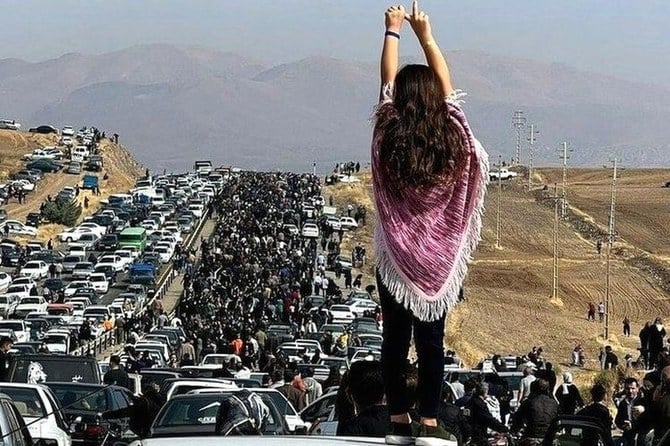محمد شبارو/عرب نيوز: قد يكون دور النساء في إيران هو المحفز الفاعل على التغيير
Women may be the catalyst for Iran’s big change
Mohamed Chebaro/Arab News/November 02/2022
Women in Iran are continuing their anti-hijab protests despite the increasingly violent tactics deployed to suffocate them wherever protests spring up, whether in the streets, marketplaces, schools or universities. The latest threat by the Islamic Revolutionary Guard Corps to crush the demonstrators, who are chanting “women, life, freedom” and calling for the overthrow of Supreme Leader Ali Khamenei, come through show trials for more than 1,000 detainees. The IRGC’s promise of long prison sentences and even the death penalty is testimony that the defiant women of Iran have further squeezed a clerical regime that is running out of options to contain the protests.
More than 250 Iranians have been killed and thousands arrested during nearly 50 days of unprecedented protests by women who are fed up with being treated as second-class citizens. They have been standing up to say enough is enough since the Sept. 16 death of Mahsa Amini, a 22-year-old woman arrested for violating the hijab rule by the so-called morality police.
Many believe that Iranian women’s continued dissent has been a long time in the making and reflects a shift from the previous politically or economically induced revolts that have tested the clerical regime of Tehran over the past two decades. Many Iranian women have long tolerated but not embraced the hijab as part of their religious, ideological or patriotic Persian identity, but now, after 44 years of being forced to wear the garment, they are saying in the open what they have always believed.
Since its inception, Iran’s regime has been restricting women’s freedom of expression, bodily autonomy, personal movement and professional opportunities, instituting legal gender discrimination against them. Women in Iran make up more than half of university graduates but form only 14 percent of its labor market.
In the last few years, the morality police has doubled down on its efforts to tighten women’s compliance with wearing the hijab, which had apparently been slipping, especially as enforcement of the dress code is a red line for the clerical regime. Government figures from 2014 showed that the branch of the police tasked with upholding Islamic moral standards warned, fined or arrested 3.6 million women for “inappropriate dress” matters.
The current conundrum facing the regime reflects, for the first time, its diminishing options on how to suffocate the protests without appearing to be using excessive force against women, which is testing its legitimacy to the extreme in the eyes of its citizens and the international community.
On the other hand, containment of the protests requires tools that the regime abandoned many years ago in its effort to tighten its grip on power, which resulted in zero tolerance for dissenting opposition voices. Over the years, even those sons and daughters of the regime who leaned toward reforms — in whatever limited space they had available — have been canceled out in favor of the unchecked power of the IRGC and its puritan approach to enforcing Iran’s extremist clerical doctrines.
The excuses deployed by the regime to paint the protesters as a foreign-induced movement have not been gaining much traction among an increasingly cynical Iranian population. If anything, the latest unprecedented report published jointly by the IRGC and the Ministry of Intelligence and Security provided further evidence of the regime’s desperation, as it repeated the mantra that the daily protests against the regime are a conspiracy by Iran’s enemies, manufactured by the US, the UK, Israel and others.
The 27,000-word report was filled with unverifiable claims, such as that “the CIA, in cooperation with allied intelligence services and reactionary proxies, launched a nationwide conspiracy in Iran before the start of those riots, with the aim of committing crimes against Iran and its territorial integrity.” The report even singled out two local female journalists who were among the first to break the story of Amini’s arrest and accused them, without providing any evidence, of being foreign spies.
The people of this oil-rich country have been starved by years of sanctions, inflicted mainly by the revolutionary regime’s political choices. But over the last decade they have expressed their impatience with Tehran’s priority of exporting its revolution by meddling in neighboring countries’ internal affairs, from Syria to Yemen and Iraq to Lebanon and Palestine. This is seen by many Iranians as the key reason for the continued deterioration of living standards in their country.
After 44 years of being forced to wear the hijab, they are now saying in the open what they have always believed.
It has long been believed that revolutions often consume their children. However, maybe in the case of Iran, it is the grandchildren who will devour the revolution. In our modern, borderless world, it is difficult to keep a young and curious generation closed in for long. It is only natural that, as citizens’ political, economic and social dividends diminish, the younger generation aspires for change.
Retreat has never been part of the Iranian revolution’s rulebook and it will not take the decision to curb the morality police’s behavior. This leaves the regime to do what it knows how to do best, and that is to raise the level of threat, intimidation and violence. This can only be a recipe for further alienation that could translate into a greater disconnect between the rulers and the ruled. For years, Iran has been waiting for its big change and it is the women who could now be the catalyst.
*Mohamed Chebaro is a British-Lebanese journalist, media consultant and trainer with more than 25 years of experience covering war, terrorism, defense, current affairs and diplomacy.






















